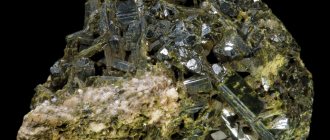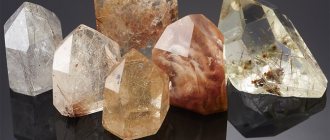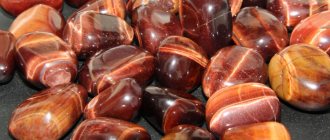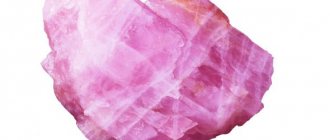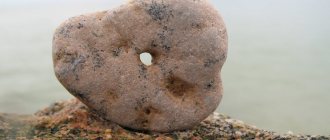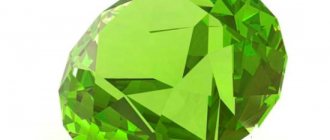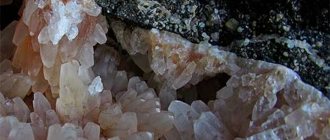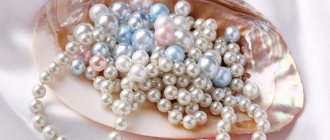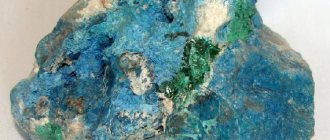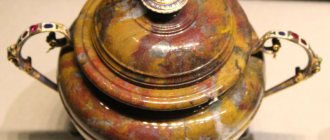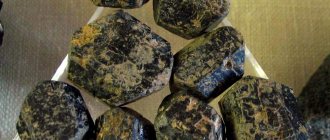During the time of the pharaohs, turquoise was brought to the country from the Sinai Peninsula. And today this place remains a place for mining turquoise and corals. The ancient mines of Wadi Magare (“Valley of Caves”) were described at the beginning of the 19th century by the German explorer Ulrich Jasper Seetzen in his travel notes. The Egyptians called these places “terraces of turquoise.” Thousands of captive slaves were sent to the waterless deserts of Sinai. This is where the cult of this stone began.
Turquoise was widely used in Egyptian jewelry, as evidenced by the mask and sarcophagus of Pharaoh Tutankhamun, whose burial archaeologists say was not the richest, although countless jewelry was found in the tomb, including with turquoise, for example, a chest decoration - a golden falcon , inlaid with turquoise and other precious stones. A turquoise scarab beetle was also found here. The Egyptians often carved such beetles, which were considered sacred, from turquoise; they served as amulets and were recognized as the most powerful in their magical powers.
A turquoise scarab beetle is the most common souvenir that you can bring as a souvenir of your trip to Egypt.
Turquoise was admired not only in Egypt. After the decline of the great Egyptian civilization, the ancient mines in Sinai were forgotten, but turquoise came to Europe from Persia (now the territory of Iran). Until now, in Iran, turquoise is considered almost a national talisman stone. The country's income from stone mining was an important part of the economy.
In Ancient Iran, turquoise was valued higher than gold. It was available only to the noble and rich. Jewelery connoisseurs say that the Shah's treasury of Iran contains a unique collection of turquoise, including the tiara of the Iranian Empress Farah Pahlavi.
In Europe, turquoise was called the “Turkish stone”. This is because many trade branches of the Great Silk Road ended in Turkey, from here ships from the East to Europe carried goods to Italy and France.
Turquoise was also considered a sacred stone among the Indians of the American continent. Large and ancient turquoise mines have been discovered in North America. As a result of excavations in the Chaco National Historical Park, archaeologists discovered tens of thousands of turquoise items. The burial of Aztec leaders was always accompanied by a huge amount of turquoise. Therefore, it is not surprising that such burials contained numerous and interesting finds.
Today, turquoise from Iran continues to be famous throughout the world. Turquoise from Arizona can compete with it. Good quality turquoise is mined in Afghanistan and Central Asian countries (Tajikistan, Uzbekistan, Kazakhstan). Turquoise deposits exist in the Caucasus, Mongolia, Israel, Ethiopia, Chile, Australia, China, and Russia.
The word "turquoise" comes from the Persian words "firuze" ("stone of happiness") and "piruz" (victory, winner). In Arabic, Firuzaj means “victorious.”
Meaning and description of the stone
The turquoise stone is called the stone of winners (from “piruz”). The word “turquoise” is translated as “stone of happiness” (from “firyuze”). The name was given in the 13th century. The main meaning is to increase the strength, luck, and intelligence of the owner. The mineral is also identified with immortality.
What does turquoise look like?
Natural turquoise has a wide palette of shades from bright blue, greenish to white, the shine of the stone is matte. The difference in color is explained by the age of the mineral:
- young - white or pale blue;
- mature – bright blue or turquoise;
- old - green, green-blue, gray, brown.
The changes are associated with constantly ongoing processes inside the stone - copper oxide is slowly replaced by iron oxide. At first the stone turns green, then turns brown.
Upon examination, white and dark dots and veins are noticeable. The former appear due to the presence of kaolinite and halloysite, the latter - due to iron oxide, quartz, and pyrite.
The stone is in most cases opaque. About 10% of mined turquoise can be classified as precious stones. These specimens are deep blue, translucent and highly prized. The remaining 90% are semi-precious.
To watch a video review about turquoise:
Varieties and colors of the mineral
Varieties of gems are distinguished according to the principles of diversity of colors and places of extraction, which makes it easier for jewelers, collectors and other people close to the life of the stone to understand each other.
Shades of turquoise:
- green – the color is due to the large amount of iron in the stone;
- white – the youngest state of the mineral, rare;
- blue - the brightest of all types, practically does not contain iron, the composition is dominated by copper;
- pink – not found in nature, obtained by coloring pale minerals or howlite;
- blue – rare, interesting to lovers of amulets, talismans, and collectors; the most valuable shade;
- pink - obtained by dyeing pale turquoise or howlite;
- red - an old stone, reddened due to an increase in the amount of copper or obtained artificially by coloring.
Where turquoise is mined:
- Arizona - bright blue, the most expensive - the price for 1 carat starts from $500 for wholesale buyers;
- Tibetan - mined in Tibet, has an exceptional variety of shades, including rare cobweb and green;
- Kazakhstani - the youngest, specimens are pale, soft, valued lower than others;
- Israeli - a rare green variety, mined mainly in Israel;
- Iranian - considered the leader in color and beauty, the hardest;
- Persian is the old name for Iranian turquoise.
There are some inaccuracies in the name that can confuse an uninitiated person:
- turquoise is called Turkish stone, but it was only imported to Turkish markets and was never mined in Turkey;
- dyed jasper, imitation of a soft turquoise color, called “African turquoise”, has no relation to Africa.
A separate type is pressed (restored or reconstructed) turquoise - pressed, crushed substandard.
Another type of turquoise is synthetic. This is an analogue of natural stone, obtained using nanotechnology. The main type of cut of turquoise is cabochon.
Physicochemical properties of turquoise
Turquoise has a complex chemical formula; it is a hydrogenated aluminum phosphate, CuAl6(OH)2·4H2O.
The mineral is opaque, with a faint waxy sheen. The color is uneven, with veins and inclusions; the color of turquoise is directly dependent on its age. A light, almost white color means that the stone is very young; sky blue is the most valuable type of “ripe” turquoise; a greenish color is characteristic of a stone at an “advanced” age. The thing is that copper is responsible for the blue color, which over time is replaced in the mineral by iron oxide, giving it a greenish tint.
History and origin of turquoise
The mineral has been known to people for 7 thousand years. The first deposits were found on the island of Sinai, where slaves were sent to mine the gem. The stone was then supplied to Suez.
Turquoise was discovered on primitive jewelry during excavations of ancient burials in Egypt. The gem was brought to Europe from Turkey, which is why it was called Turkish stone. She made inlays on the throne of B. Godunov.
I. the Terrible often held the gem in his palms, showing others the change in its color.
The stone was attributed special significance in the world of magic:
- Turkish warriors wore amulets to protect themselves and their horses during hostilities;
- travelers considered them their patron on the road, helping to preserve property and resist theft;
- Arabs and Persians decorated their weapons, believing that the stone would change color in case of danger;
- in Ancient Egypt it served as material for the manufacture of sacred scarab beetles;
- among the Aztecs, the gem was used to perform rituals and decorated masks;
- a medieval lady sewed turquoise onto the clothes of her chosen one so that he would fall in love with her forever.
The formation of the mineral occurs in sedimentary rocks under the influence of certain temperatures, oxidation, and weathering. It occurs in the form of cryptocrystalline dense masses, small round inclusions or in the form of a cluster, crusts.
Artificial turquoise
Since natural reserves are rapidly depleting, today about 80% of the jewelry market is represented by synthetic turquoise. There are many methods of counterfeiting, from pressing powders of other minerals and then painting them to imitations made of plastic and bone. It is unlikely that the seller will allow a full examination of the stone using chemicals, so in order to distinguish real turquoise from a fake, you must first of all pay attention to the large size of the stones, its very rich and perfectly uniform color.
Where is turquoise mined and how is it processed?
Main stone quarrying centers:
- America;
- Iran;
- Mexico;
- Afghanistan;
- Armenia;
- Brazil;
- Turkmenistan.
Due to its low hardness, the mineral is poorly suited to any processing, including cutting. Grinding is also not applicable to gemstones. It is inserted into jewelry as a round cabochon or made into beads.
View this post on Instagram
Posted by Bijuteria (@bijuteria_007) Apr 12, 2021 at 5:51 PDT
Tests by fire and needle
If you take real turquoise in your hand, the stone will seem cold. However, the mineral will gradually heat up. Synthetic samples lack this ability. It is easy to spot a fake by fire testing. When heated in the flame of a match or candle, it emits a melting smell.
To avoid accidentally damaging the decoration, conduct the experiment on the side hidden from view. It is acceptable if natural turquoise shows cracks in the direction of the veins. When a more durable howlite is used in the simulation, its appearance will not change.
A similar test method is to pierce the sample with a hot needle. The plastic will melt, and the turquoise-colored stone at the puncture site will become lighter. If you see a stabilized type of mineral, then it is quite possible that the impregnation used will appear.
Scratching with a needle will also help identify a fake. But such manipulations need to be done only on the back side of the stone. The plastic will begin to crumble, the howlite will pass the test, and the remaining scratch will confirm that it is real turquoise.
How to distinguish natural turquoise from a fake at home
This natural mineral is rarely found on the market. The demand for the stone is high, the price is high, so fake or artificially obtained specimens are sold under the guise of a natural gem.
Alchemist Agricola wrote back in the 16th century: “No other precious stone can be imitated so indistinguishably as turquoise...”.
The oldest imitation was made 4000 years ago in Egypt using painted glass. Tutankhamun's beads were also fake.
To improve the appearance of the stone, exposure to chemicals is used, while its properties are preserved.
- Stabilization is due to the ability of the mineral to absorb chemical compounds. To give it a waxy shine, it is soaked in epoxy resin or paraffin.
- Coloring - the gem is immersed in a solution of dyes of an unnatural color for it. After this, it acquires pink, purple, and red colors. This is mainly done in China. The structure of the stone does not change. Another name is refined turquoise.
They learned how to create the mineral 100 years ago. There are 2 ways to do this:
- A stone that is chemically identical to natural is obtained by alloying aluminum hydroxide and copper phosphate. The result is a bright blue specimen, less often with a yellow tint.
- Pressing turquoise fragments; other rocks can be added to increase volume and reduce cost. The resulting samples are similar to the original, it is difficult to distinguish.
The most common method of counterfeiting is imitation turquoise. For this we use:
- painted plastic;
- colored caulite (calcium borosilicate);
- glass;
- burnt alabaster or plaster;
- turquenite (a type of caulite);
- other stones similar to turquoise: chalcedony, jasper, magnesite, odontolite and others.
Fake stones wear out quickly and do not have the physical, healing, and magical properties of natural turquoise.
A method for producing nanoturquoise was invented in Russia. Under the influence of a certain temperature and humidity, artificial crystals are obtained. Production is cheaper than originals and always guarantees results, unlike excavations.
In terms of physical and chemical qualities, synthetic stones are identical to natural ones, but do not have healing and magical qualities. If these aspects are not important to the buyer, then artificial turquoise is a worthy replacement for natural one.
A well-executed imitation is difficult to recognize; fakes are cheaper and easier. The main ways to find the differences between natural stone and fake:
- If you wipe the product with water or alcohol, some of the paint may remain on the rag. This will indicate the cheapest fake.
- When mechanical damage is caused by a needle, a white furrow will remain - the paint on the fake will be erased.
- When exposed to temperature, the plastic begins to melt and emit a chemical smell; it is easily pierced with a hot needle or awl. A real mineral will crack when exposed to extreme heat.
- Fake beads will give themselves away by a change in color near the holes. If the beads on the fishing line are lighter, then it is not the original.
- Natural gemstones are often small; larger specimens have a non-uniform color. Large homogeneous stones - imitation or turquenite.
- The fake has a glassy sheen and a dense surface. Turquoise has a matte shine and a porous structure.
- If you look at the glass imitation through a magnifying glass, you will find small air bubbles.
- Real turquoise is expensive. If the price is suspiciously low, then you should refrain from purchasing.
In addition to the topic, watch the video:
Mines of the Pharaohs
The greenish-blue stone was very popular with the ancient Egyptians, although it was valued less than the deep blue lapis lazuli. The latter was brought from a distant unknown country, Northern Afghanistan, and turquoise, like malachite, was mined nearby, in the Sinai mines, which supplied Egypt and the entire Mediterranean with copper. The ancient turquoise mines in the western part of the Sinai Peninsula began to be developed during the time of the first pharaohs.
Here, in the red Nubian sandstones, in an area rich in copper ores, the first turquoise was found; here, for the first time, the cult of this stone began in the products of Egypt and its blue scarab beetles, for which thousands of captive slaves were sent to the waterless deserts of Sinai. – wrote Alexander Evgenievich Fersman.
On the hand of an Egyptian mummy buried 6 thousand years BC. BC, four gold bracelets with turquoise from the Sinai mines were discovered. In these bracelets, old, but still blue, turquoise is set in an elegant frame and framed with hollow gold beads.
Turquoise grinders in Pakistan Photo: mirmineralov.ru
The most famous of the ancient turquoise mines is called the Valley of Caves. As the Ancient Egyptian state declined, the Sinai mines were abandoned, but not worked out. After in 105 AD. e. The area was occupied by the Romans and mining of the precious stone was resumed. In the Middle Ages, the mines of the pharaohs were forgotten again. Nowadays, local residents, looking for ancient workings, go down into them and sometimes find turquoise suitable for sale.
Properties and uses of stone
Areas of application:
- production of decorative jewelry;
- making souvenirs;
- use in lithotherapy;
- wearing as a talisman or talisman;
- collecting.
Physical properties
The stone contains copper, iron, aluminum, which determines its properties:
- opaque, rarely translucent;
- waxy shine;
- density 2.7 g/cm³;
- at the break the edge is uneven;
- hardness 5–6 on the Mohs scale (depending on color).
Medicinal properties
The stone is used for medicinal purposes. It is believed to help with:
- headaches, migraines;
- stress, depression;
- emotional lability, neurosis;
- liver diseases, ulcers, gastritis;
- inflammatory processes;
- colds, bronchitis;
- bleeding;
- rheumatism;
- eye diseases;
- reduced immunity;
- heart pathologies.
Video review from a lithotherapist about the beneficial and extraordinary properties of the stone:
Magic properties
Since ancient times, the gem has been a symbol of love, happiness, and has been endowed with magical qualities:
- Changes the owner for the better - makes him kinder, more merciful. The stone helps to find the good in others and to reconcile those who have quarreled.
- According to magicians, Turkish turquoise protects the owner from the evil eye and damage. Protects against energy vampirism.
- Gives confidence in the correctness of an action or decision. Helps to avoid miscalculations and mistakes.
- Gives harmony, a subtle attitude, promotes knowledge of the environment. Reveals talents and abilities.
- Protects from troubles, warns of illness. The gem fades - the owner has depression or a serious illness.
Combines with opaque dense gemstones: aventurine, agate, jasper, malachite, quartz.
It is not recommended to combine wearing with fire stones: red garnet, tourmaline, zirconium, ruby, diamond.
Why do you dream about turquoise?
According to the dream book, turquoise is a good sign (with rare exceptions):
- Seeing turquoise being given as a gift in a dream means the fulfillment of a cherished desire. If colleagues are present, then management will evaluate the work of the one who saw the dream.
- Receiving women's jewelry with a mineral as a gift means the appearance of a source of pleasant troubles and surprises in the form of a stranger. Giving someone turquoise is doing a favor. If you dream that a gem is given to a woman, then it means a forced service.
- If a woman’s turquoise was stolen or she lost it, this means future trials in love and relationships.
- If turquoise decorates clothes in a dream, it is a pleasant surprise. Seeing a product with a blue stone is an event that can affect your future life.
- A mineral can dim and stop glowing not only in reality, but also in a dream. If a person saw such a dream, turquoise is interpreted as a warning about envious people and ill-wishers.
Other cases of turquoise seen in a dream are considered harbingers of the imminent fulfillment of desires.
Who is the mineral suitable for according to their zodiac sign?
Turquoise has a different effect on each zodiac sign:
- Taurus will become more balanced, learn to control their words and emotions, the recommended color is green;
- Sagittarians receive luck, self-confidence, love from friends and others, harmony, they should wear white turquoise;
- Scorpios will become more confident in themselves, reduce their temper, aggression towards others, the best choice is a green mineral;
- For Aries, the gem will help to discover and develop talent, become more restrained, teach them to restrain impulsiveness, the color of choice is white;
- Pisces will understand that luck accompanies them in everything;
- Capricorns will rise through the ranks and become more attractive in the eyes of others;
- Virgos will feel the harmony of the mineral with their inner world, they will become calmer, more patient, the optimal stone is white;
- Aquarius will be made more active and purposeful;
- It will help Libra in the fight against melancholy, low self-esteem, and reconcile with the feeling of the transience of time;
- He will put Gemini in a philosophical mood and direct his energy in the right direction;
- Cancers will arrange their personal lives and gain recognition from others.
Astrologers categorically do not recommend wearing a stone for Leos. It can lead the owner to discord with himself, loss of inner harmony, depression, and apathy.
Beliefs and legends
There is not a single stone that plays a greater role in human superstitions than Persian turquoise, says academician Fersman.
In truth, this is true not only for stone mined in Persia. Turquoise plays a special role in the culture of the Middle Eastern countries, the Far East, and the peoples of the very distant, overseas West. The beliefs associated with this stone are very diverse and sometimes contradictory.
As the name suggests, the ancient Persians revered turquoise as a talisman for warriors, bringing victory. A similar idea existed in Western Europe in the 17th and 18th centuries. Oddly enough, the delicate blue stone was then considered purely masculine. It was believed that it protected the owner from wounds, bruises, and falling from a horse. This idea was probably borrowed from the East.
In addition to the ability to bring victory, the Persians attributed magical power over horses to turquoise. An amulet made from this stone was supposed to help curb the most restive horse. Nowadays, in many museums around the world one can see material evidence of the prevalence of such a belief - horse harness richly decorated with turquoise.
The Pueblo Indians believed that wearing turquoise protected against lightning strikes, and the ancient Indians prescribed looking for turquoise where a rainbow that appeared after a thunderstorm touched the ground.
Photo: www.liveinternet.ru
At the same time, turquoise is a love talisman. According to one eastern legend, it arose in the earth from the bones of those who died from unprecedented love. The lovers often exchanged turquoise gifts. It is believed that if the passion in the heart of one of them begins to cool, the stone given to them will fade. It is believed that sewing a piece of turquoise into a lover’s clothes is a reliable love spell. In many eastern countries there is a custom of placing turquoise in the cradle of a newborn girl. When the baby grows up and becomes a bride, she will have to give this stone to her chosen one. In the future, the treasured turquoise will serve as a family amulet and help reconcile quarreling spouses.
The last belief is a clear illustration of how the symbolism of an object can change to the opposite. A blue pebble is given to a newborn girl precisely because it is a male military talisman intended as a gift for the groom. But over time, the reason for the custom was somehow forgotten, and now turquoise is most often perceived as a girl’s gem.
Stone jewelry
Turquoise looks good with clothes in white, beige, and gold shades. A white dress goes with a bracelet, earrings go with a light blouse and a black skirt, beads go well with a beige suit, and a ring can be worn with any outfit.
View this post on Instagram
Posted by ALCOZER&J (@alcozer_belgorod) Jun 5, 2021 at 10:13 PDT
View this post on Instagram
Publication from Jewelry with Soul (@lana_tribus_braclets) Jun 4, 2019 at 11:32 PDT
View this post on Instagram
Posted by Svetlana Gural (@svetlana__gural) Jun 3, 2021 at 11:45 PDT
Caring for stone and products
Turquoise is a fragile stone that requires careful handling. To extend its service life, you need to follow the basic rules:
- store in a case;
- do not expose to high temperatures;
- clean the mineral once a month;
- avoid contact with alkalis, abrasives, acids - the turquoise will darken;
- Avoid exposure to direct sunlight - the stone will lose transparency;
- wear without using cosmetics (deodorant, varnish, soap, lotion, etc.).
You can clean turquoise at home by washing the stone with clean water or jewelry cleaner. After washing, dry thoroughly with a soft towel.
Who suits turquoise according to the horoscope?
Products made from turquoise
Astrologers are unanimous about which zodiac signs benefit from the gem.
It is believed that turquoise does not suit everyone's zodiac sign.
According to the horoscope, choose a pebble of its color:
- blue - Sagittarius, Aquarius, Gemini;
- green - Scorpio, Taurus;
- white - Pisces, Aries, Virgo.
For the rest of the zodiac sign, a mineral of bluish-gray shades is suitable. According to astrologers, turquoise is contraindicated for Leo: its help is more likely to harm. The pebble may be suitable for the month of birth: February - dark blue stone, March - blue, July - green, August - any.
| Zodiac sign | Compatibility (“+++” – fits perfectly, “+” – can be worn, “-” – strictly contraindicated) |
| Aries | + |
| Taurus | +++ |
| Twins | + |
| Cancer | + |
| a lion | — |
| Virgo | + |
| Scales | + |
| Scorpion | + |
| Sagittarius | +++ |
| Capricorn | + |
| Aquarius | + |
| Fish | + |
We look inside and put pressure on the psyche
Now we’ll tell you how to distinguish natural turquoise in beads. A visual inspection of the internal hole is sufficient here. If it retains the basic color, then the stone is genuine.
Also remember that natural turquoise does not come in large sizes. Usually the gem does not exceed 1 cubic meter. cm in volume. However, if you press small particles, you get large stones. The cost of the product also makes it possible to recognize its naturalness. The price of the original is 10-15 thousand rubles. Smaller amounts make you think - it is quite possible that this is artificial turquoise.
If the purchase is made in a specialized store, then it is possible to see the certificate. Forgery of a document is possible, but asking to show it has a magical effect. Fraudsters appear confused.
The certificate of conformity indicates the variety offered for sale. Then it’s easy to find out what exactly is in front of you. But it is best to seek advice from a professional who understands turquoise and knows for sure how to distinguish a fake. Therefore, we advise you to look for proven gemologists who constantly work with the rock and jewelry.
Origin of the mineral
Formation under natural conditions occurs in the presence of heated water (up to 170-180°C in the presence of pressure) flowing in rocks. Feldspars, apatites, alumina, limonite, copper-bearing rocks - these are the basis and accompanying masses of turquoise. Several centuries - and underground conditions led to the formation of this gem.
Interesting: some deposits are distinguished by obvious traces of animal organics - teeth and bones of various animals are regularly found in the masses of turquoise.
One of the best varieties, Iranian turquoise was formed during rock eruptions. The mixing of liquid rocks, oxidized in atmospheric conditions and altered at high temperatures, led to the formation of turquoise.
Where is it mined and used?
The gem is mined in deposits that have been developed for a long time - due to the not very powerful reserves of this mineral. Due to the development of the mines (they are mined only using closed methods), the process requires considerable costs.
The bulk of turquoise is mined during the development of copper deposits. The following can boast of such deposits:
- Iran;
- Argentina;
- Afghanistan;
- Turmenia;
- Egypt;
- Australia;
- Armenia;
- Tajikistan;
- Uzbekistan;
- Tanzania;
- USA.
The highest quality stone is Iranian - from deposits in the Nishapur region. Local raw materials produce a pale blue product.
The most common uses for the gemstone are:
- as early as 8 thousand years ago, tribes and peoples made jewelry from it for the body, clothing, and interiors - for example, mosaic panels of the Aztecs and parts of the handles of Inca weapons;
- the ancient Egyptians used it to create figurines of scarabs, amulets and simply decorations (in addition to wealthy citizens, every pharaoh had such);
- later peoples decorated themselves and their animals with amulets, applied stone plates to weapons and protective clothing, and used them to decorate the premises of rulers;
- Today, turquoise is a means of aesthetics: it is used for rings, earrings, pendants, pendants and other jewelry.
The bulk of products sold include artificial stone. Its color can completely replicate the natural one, but it still needs to be clarified. Variscite, howlite and chrysocolla are used as substitutes.
Interesting: “turquoise” is the name given to the 18th anniversary of family life; on this date it is customary to give products with the appropriate finish or at least the appropriate color.
How to distinguish from a fake
A real gem is almost opaque, has a waxy luster and has many color options. The main ones:
- green (color saturation is controlled by the amount of iron and vanadium - from deep to light green with a blue tint, or bright green, grassy);
- blue (variations in copper content - from strong blue to soft blue), and it is because of the deep blue that the name of the stone, “turquoise”, came about;
- violet (strontium changes its color to blue);
- yellowish, brown and even brown (iron hydroxides).
With a high content of quartz and kaolinite, the pebble becomes discolored and acquires a gray color.
Real turquoise is porous and reacts to significant temperature fluctuations. Direct sunlight, contact with household chemicals and cosmetics can lead to fading and destruction.
Interesting: there is “African” turquoise - a delicate color, but it is an imitation of jasper. Pink turquoise is produced from ordinary pale turquoise by ordinary tinting.
Turquoise in feng shui
Eastern philosophies view turquoise as the personification of prosperity and wealth. It is a symbol of everything beautiful and precious, aesthetically pleasing and bringing noble tranquility.
The meaning of the stone as a symbol of the Tree is known - because of the greenish color, it is customary to associate the mineral with living nature. However, it is noted that it is better to use a purer green.
Important: color and texture can add some volume to a room, brightening and enlarging it at the same time.
Green turquoise looks beautiful together with light and beige shades. It gives balance and poise to bright (primarily red) colors, generating overall harmony.
It is recommended to place turquoise in the western direction - it is believed that a stone placed from the East can disrupt energy flows. Its role in the movement of energies is to increase a person’s resistance to physical influences.
Turquoise stone has a positive effect on the immune system and relieves stress. It is considered beneficial to meditate in a room (or corner) that has decorations or objects made from this crystal.
The practice of Feng Shui notes that when decorating a home, turquoise or similar colors are very good for walls (wallpaper) - it evens out the flow of energy and calms the soul. However, it is recommended to use shades that are closer to blue tones - the green range is more related to inanimate nature and spirits. But both options will look nice.
Amulets, amulets and talismans
Firuza (a Persian word meaning “stone of happiness”) has been considered since time immemorial as a product that attracts health, luck and prosperity in any form. Its appearance and mysterious color make it a beautiful stone for any jewelry, including protective and protective ones.
Amulets and products around which legends sounded have excited the minds of people for centuries. The stone of health and happiness, which is induced by a light glow, is a keeper in itself.
Turquoise has always been considered useful for people associated with distances and travel. Traders and travelers carried it with them because of the belief that the properties of the mineral could protect them from various troubles.
Compatibility with other stones
Practice shows: turquoise by itself is not carried around; other minerals are almost guaranteed to be nearby. Not all of them will support this union, but some are recommended for wearing together:
- nephritis;
- coral;
- pearl;
- amazonite;
- jasper;
- malachite;
- agate.
The remaining stones should be selected with an experienced astrologer or an understanding person. The main thing is not to wear “water” turquoise together with stones belonging to the element of Fire. Such a union is capable of neutralizing the useful capabilities of both gems.
For men
The “strong” gender is provided by turquoise with a certain masculinity and courage. Behavior is quite tangibly supported and strengthened. Business representatives need a talisman - it simultaneously strengthens their own confidence and protects them from the negative impact of competitors.
A man will become more tolerant - this is important for communication and conflict resolution.
For women
Turquoise gives the “weaker” sex increased interest from all men - the natural physical and mental beauty of a woman receives inexplicable support.
Interesting: popular rumor ascribes to the mineral the ability to bring marriage closer.
For married ladies, the gem helps in the turbulent world of everyday life - the stone will protect spouses from squabbles, and will bring passion back into the relationship. The husband whose wife puts the jewelry in his bag will get the desire to get back home.
How to wear and care
For wearing, it is recommended to combine with noble gold or silver - their general properties will be mutually enhanced. A special effect has been noted on people whose eye color matches that of the pebble:
- light-colored products - for people with blue or green eyes;
- dark - for brown-eyed individuals.
Caring for this ancient mineral does not require any special skills. Cleaning is recommended with a soft cloth, without soap or household chemicals. You just need to put the jewelry in water for a few minutes, and then wipe it with gentle movements.
The product should not be exposed to overheating or sunlight - cracks and a decrease in shade depth are very likely. The latter is also possible when in contact with chemistry and perfumes.
The preservation of color and its saturation is maintained by periodic greasing - 1-2 times a year.
Who is the mineral not recommended for?
Astrologers believe that a stone in any form is not very suitable for people who think in a negative way and wish harm for others. People who are quick-tempered and prone to depression will not receive miraculous changes in their lives.
A person must determine his “pole” for himself - otherwise his own nature will lead to a radical change in the impact of the stone. As a result, attention will begin to dissipate, thoughts will become wandering, and the state will become permanently depressed.

